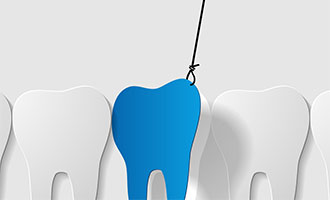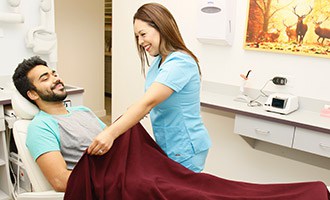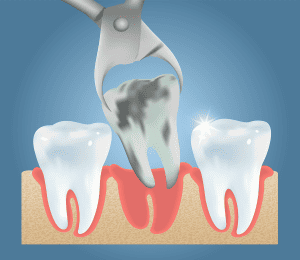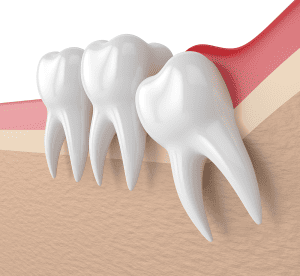
Dr. Bhave is very skilled at saving teeth, and will do everything she can to preserve them. However, sometimes a tooth is too decayed or damaged to be saved, and needs to be extracted in order to prevent infections and swelling.
As a prosthodontist, Dr. Bhave is a dental specialist in restoring broken-down teeth and replacing teeth. Sometimes, this requires extractions of compromised teeth. Dr. Bhave precisely extracts teeth so the surrounding tissues are preserved and the experience is comfortable. She can also rebuild the bone volume where the tooth has been extracted so a future dental implant can be placed stably.
Minimally Invasive Tooth Extraction Details
Dr. Bhave first examines x-rays of the tooth to be extracted. She inspects the anatomy of the tooth and its exact position relative to other structures. She plans the extraction so it does no damage to the surrounding anatomy.
She uses special instruments that allow her to remove the tooth with little to no trauma or damage to the surrounding gum and bone. This minimizes swelling and post-treatment discomfort, and speeds the healing process.

Dr. Bhave ensures you are comfortable throughout the procedure. She explains what will happen before she starts so you are informed and can feel at ease. Her injections are administered slowly so there is no uncomfortable sensation.
We have blankets, pillows and headphones for your added comfort in the dental chair. There is also music and TV available to you in the treatment room.
Socket Bone Graft for Dental Implant or Bridge
After a tooth is extracted, bone loss occurs where the tooth is missing. The bone loss creates a sunken area on the dental arch that can create difficulties if you wish to replace your missing tooth with a dental implant or a dental bridge in the future.
A sunken part of the arch usually has too little bone to support a dental implant. It can also cause difficulties after receiving a dental bridge, as food can become trapped in the sunken space under the bridge and breed bacteria which lead to infection.
Immediately following the extraction, Dr. Bhave can place bone graft material in the empty socket to stimulate regeneration of new bone tissue. The new bone will preserve the height and thickness of the jaw ridge where the tooth is missing, and will prepare the site for a future dental implant or dental bridge. The procedure is commonly known as a socket graft or ridge preservation.
Tooth Removal FAQ
What is tooth extraction?
Tooth extraction refers to a procedure that involves removing a tooth entirely from its socket. It is the term used to describe having a tooth “pulled.”
When is a tooth extraction necessary?
Dr. Bhave prefers to save natural teeth when possible. However, some cases will not benefit from other restorative treatments, such as fillings or crowns. If the tooth is severely damaged and repair is not possible, then tooth extraction may be necessary. Tooth extraction is often recommended in the following cases:
- Severe decay
- Badly fractured tooth
- A tooth that is impacted
- Crowded teeth
- Advanced-stage gum disease
- Tooth luxation
What does a tooth extraction involve?
Ahead of your tooth extraction, Dr. Bhave will assess your affected tooth and gum area. You will have X-rays taken so that the extent of damage can be properly assessed.
During the procedure, a special agent will be applied to numb the treatment area. You may also be provided with sedation based on your needs. Special instruments will then be used to gently loosen the tooth and remove it from its socket. In some cases, Dr. Bhave may need to make an incision in the gum to better access the tooth, such as one that is severely damaged or broken at the gum line.
After your tooth is removed, the tooth socket is cleansed and thoroughly disinfected. Stitches may be required to help encourage healing. Gauze is applied to control bleeding and promote clotting.
What are the benefits of having a tooth pulled?
There are many benefits that accompany tooth extraction. One of the most significant benefits of the procedure is the reduction of harmful bacteria from a decayed tooth, which, if left untreated, can lead to extensive damage.
Does tooth extraction hurt?
Many patients find that the most significant pain related to tooth extraction results from the damaged tooth that needs to be removed. In fact, tooth extraction can help alleviate dental pain almost immediately, especially in cases of severe damage. The team at Bay Area Dental Specialists is dedicated to your comfort and safety at all stages of your tooth extraction. The appropriate numbing agents will be used during your procedure to minimize pain. Some patients require additional help staying relaxed while undergoing dental procedures such as tooth extraction, which is why sedation dentistry is available to help reduce anxiety and make you more comfortable.
What is tooth extraction recovery like?
Before your procedure, you will be provided with detailed aftercare instructions, including information on what to expect during the stages of recovery and restricted activities. Following the removal of the tooth, you may experience bleeding and swelling. Discomfort is normal at this stage but is well managed with pain medication. The length of your recovery period depends on the severity of your case, but many patients feel like they are ready to jump back into their normal routines after a few days. Despite how you feel, it is important to adhere to Dr. Bhave’s instructions to avoid complications and ensure proper healing. These instructions may include:
- Keeping the extraction site clean
- Taking all prescribed medications as instructed
- Avoiding activity after your procedure
- Avoiding eating hard foods
What can I do to improve wound healing after tooth extraction?
How well you care for the extraction site will affect how well your tissues heal and how quickly. Follow Dr. Bhave’s post-surgical instructions precisely to avoid complications and ensure a smooth recovery after tooth extraction.
- Do not smoke or use a straw.
- Use ice packs to ease swelling.
- Rinse with saline water to clear debris from the affected tissues.
- Keep your head elevated to stop bleeding.
- Eat foods that don’t require a lot of chewing.
You can brush and floss like usual but take care to avoid the extraction site. You will need to take it easy for 24 to 48 hours.
What happens to my tooth after it’s removed?

Are there complications or risks associated with tooth extraction?
Removing the damaged tooth is often best to eliminate harmful bacteria and stop the spread of an infection or decay. Tooth extraction may be your best option for restoring good oral health. However, all procedures come with risks. Tooth extraction carries some minor risks or potential complications, including dry socket, nerve injury, post-surgical infection, delayed healing, and perforation of the maxillary sinus (the hollow area inside the bones of the nasal structure).
A dry socket is rare (1% to 3%) but is the most common concern after tooth extraction. It is a painful complication that happens when a blood clot fails to form in the area or dissolves before the wound is healed fully. Without the blood clot in the empty socket, the underlying nerves and bone are exposed, causing significant pain that may radiate around the neck, ear, eye, or temple. A dry socket can cause a foul taste or bad breath and may develop around three or four days after tooth extraction. Patients have a low risk of dry sockets, especially if they follow post-op instructions and do not smoke or use a straw during recovery. The sucking action employed while using a straw or smoking a cigarette can dislodge the blood clot.
Contact Dr. Bhave if you experience a 100.4-degree fever or higher, severe pain that doesn’t go away with medication, or drainage from the extraction site.
Should I avoid certain foods after a tooth extraction?
It’s best to eat soft foods like eggs, yogurt, applesauce, pasta, and rice. Hard or crunchy foods can be difficult to eat after a tooth extraction due to the swelling and discomfort around the removed tooth.
Is it always necessary to remove wisdom teeth?

However, healthy, fully erupted, correctly positioned wisdom teeth can remain in place if there are no issues with cleaning them as part of your daily brushing and flossing routine.



